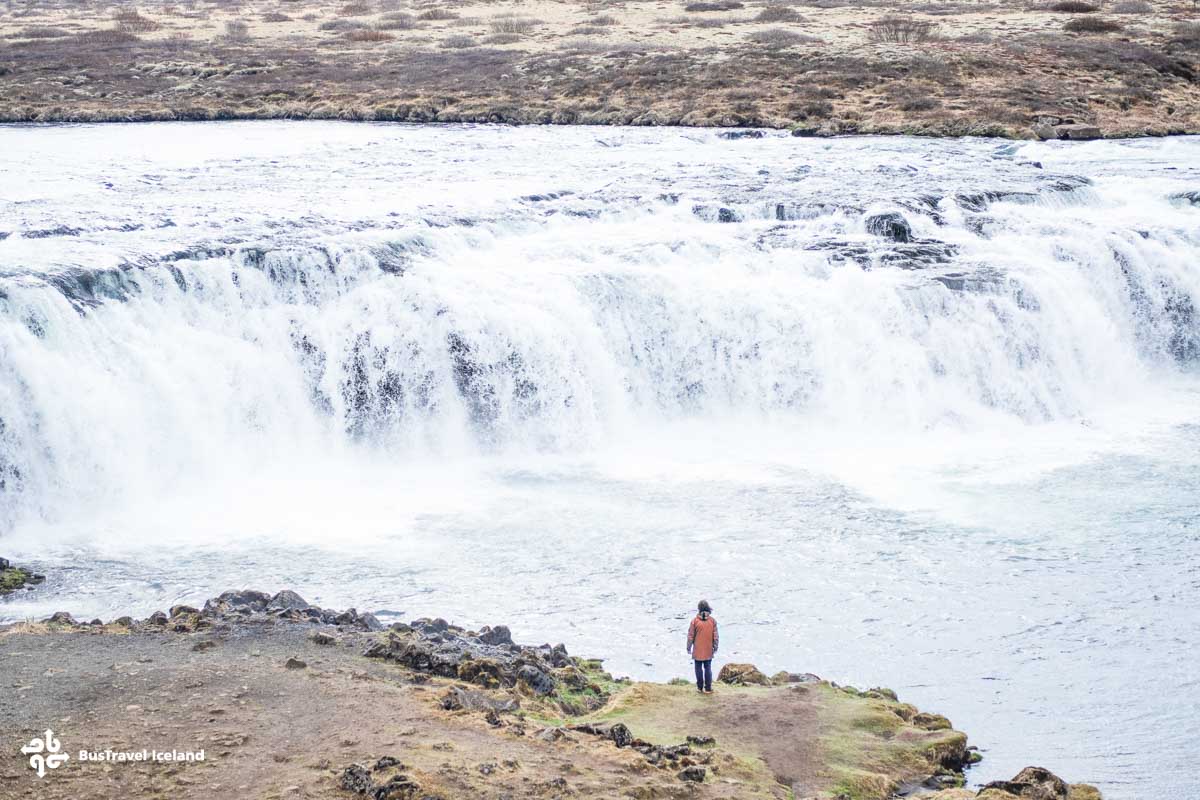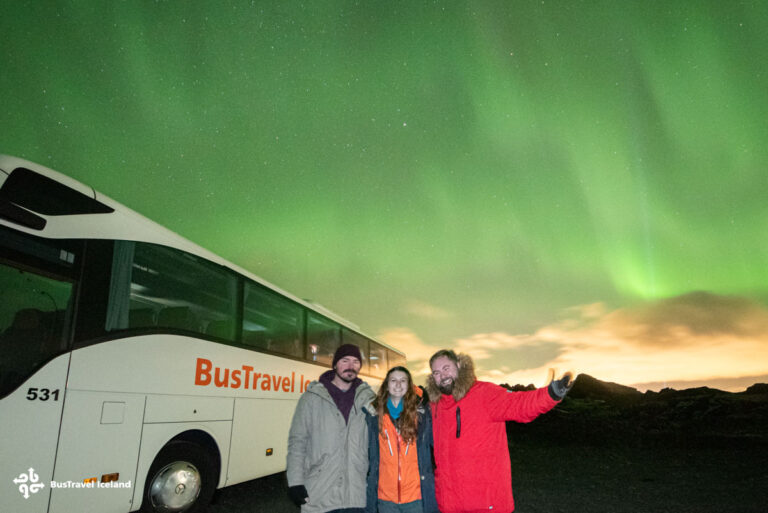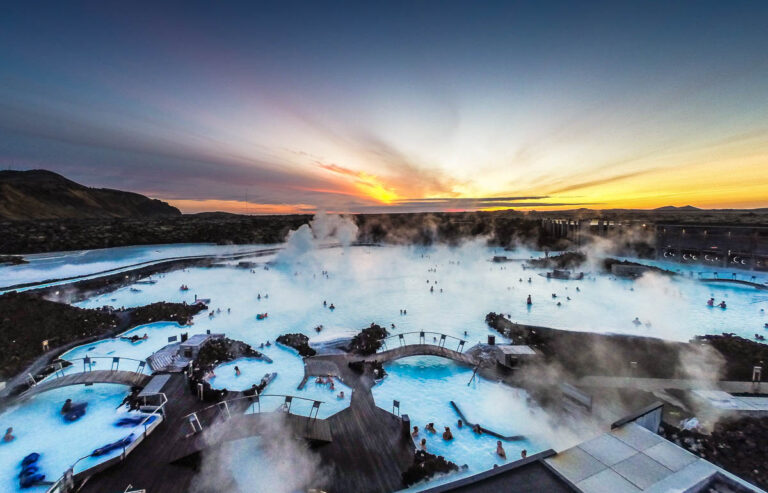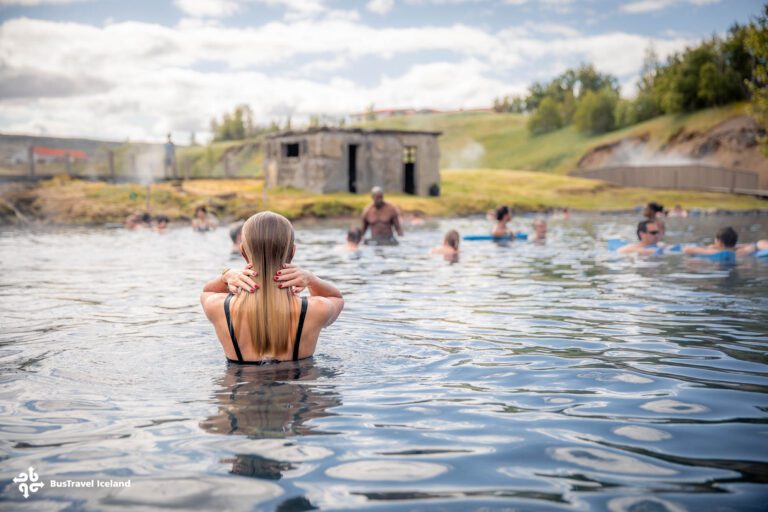Guide to Brúarfoss Waterfall in the Golden Circle
- Golden Circle Iceland
- 5 Jan 2024
Discover the enchanting Brúarfoss Waterfall, a secret gem located in Golden Circle's breathtaking landscapes. While it may not be as well-known as some of the larger waterfalls, Brúarfoss captivates its visitors with its exceptionally vibrant blue water, which is its most unique and striking trait.

Where is Brúarfoss Waterfall Located
Brúarfoss is located within the heart of Iceland’s Golden Circle, a region celebrated for its stunning landscapes and dynamic terrain. Your journey to this waterfall places you approximately 95 km (59 miles ) east of Reykjavik, within a drive that typically lasts about 1.5 hours.
The waterfall is not directly visible from the road, requiring a short hike to reveal its stunning blue waters and picturesque surroundings. As you explore further, you’ll discover that Brúarfoss is a part of a larger river system known as Brúará, where the water’s intense clarity and blue hue distinguish it as one of Iceland’s most beautiful waterfalls.

What’s So Unique About Bruarfoss Waterfall
In Iceland’s tranquil landscapes, Brúarfoss Waterfall stands out with its vivid blue color and graceful flow.
This vivid blue color, more intense than many other waterfalls in the region, is due to the natural glacial sediments and minerals in the water.
Brúarfoss is particularly notable for its unique, braided flow. The water streams elegantly through a series of small channels, resembling braids, as it cascades over the rocky terrain. This creates a multitude of mini waterfalls and currents that intertwine and separate, giving Brúarfoss a delicate and intricate appearance.
The braided flow, combined with the vivid blue color of the glacial water, and together with the contrast against the dark volcanic rock and lush green surroundings, makes Brúarfoss particularly enchanting and picturesque.
Here, time seems to slow, offering a moment of peace and a connection with nature’s quiet strength.

Bruarfoss’ Name
Brúarfoss Waterfall gets its name from the Icelandic word “Brúar,” which means “bridge.” The name likely references a natural or man-made bridge that was or is in the vicinity of the waterfall. This name is quite fitting, as the waterfall’s waters cascade over and around rocks, creating a visual semblance to a bridge over the vibrant blue waters.
“Brúarárfoss” is an alternative name for Brúarfoss Waterfall. In Icelandic, adding “á” (which means “river”) into the name emphasizes the waterfall’s connection with the Brúará river, from which it flows. So, “Brúarárfoss” can be translated to mean the waterfall of the Brúará river.

Bruarfoss in Iceland’s Golden Circle
The Golden Circle is a popular tourist route in Iceland that features several of the country’s most famous natural landmarks. Brúarfoss Waterfall is situated just off this well-traveled path, making it a convenient addition to your Golden Circle itinerary.
The waterfall lies close to prominent attractions such as Þingvellir National Park (50 km, 45 minutes drive), the geothermal area of Geysir (15 km, 12 minutes drive), and Gullfoss (25 km, 22 minutes drive).
When traveling the Golden Circle, Brúarfoss can be considered an intimate and rewarding detour, one that leads you to an off-the-beaten-path location between Laugarvatn and the Secret Lagoon. These strategic proximities allow you to seamlessly integrate the captivating sight of Brúarfoss into your complete exploration of the Golden Circle.

About Brunarfoss’ Surroundings
Brúarfoss Waterfall, known for its stunning blue waters, is a wonder of geology and hydrology that also supports an array of flora and fauna. As you explore, you’ll discover the interplay of volcanic rock, the power of the Brúará river, and the delicate ecosystems that flourish in this mesmerizing corner of nature.
Surrounding Features
The geology of Brúarfoss Waterfall is marked by volcanic rock formations that are a testament to Iceland’s fiery origins. The river Brúará, fed by a glacial river, cascades into a series of waterfalls—Brúarfoss, Hlauptungufoss, and Miðfoss—creating a spectacle of rapids and pools that boast an extraordinary shade of blue. The blue water is a result of glacial silt and minerals, which refract light and give the falls the iconic color.

Flora and Fauna
The verdant landscapes surrounding Brúarfoss Waterfall are home to various plant species, which create a verdant backdrop against the volcanic earth. As you explore, you may encounter the subtle yet resilient wildlife that inhabits these areas. The riverbanks host a delicate ecological balance, where each species, from mosses to small mammals, plays a crucial role in sustaining the nature of this unique environment.
Bruarfoss Waterfalls’ in Icelandic Culture
Brúarfoss Waterfall is not just renowned for its beautiful appearance, but also for its place in Iceland’s storied past. The area surrounding the falls serves as a silent witness to both human history and mythical tales that are woven into the fabric of Icelandic culture.

Historical Sites Nearby
At Brúarfoss, you’re treading on ground that echoes with the historical significance of the Skálholt Episcopal See. This was once a bustling religious and educational center from the 11th to the 18th century, led by influential bishops. It’s a place where you can feel the weight of history, among other historical sites that delineate stories of resilience during challenging times, including famines that tested the mettle of the nation.
The Golden Circle region, where Brúarfoss is located, is dotted with summer houses, a testament to Iceland’s fondness for the great outdoors and its respect for historical lands. As you soak in the sights, you’re reminded of Iceland’s ongoing story, one that’s deeply connected to these lands.
Local Legends and Folklore
Mythic lore is stitched into the Icelandic landscape as much as the moss on lava rock, and Brúarfoss is no exception. Whispers of local legends swirl around the cascading blue waters that might have once flowed beneath a natural stone arch. It is said to have been destroyed by a minion of the Skálholt Episcopal See, permanently reshaping the falls and altering the course of the Brúará river.
Your imagination can run wild with tales of hidden people and trolls that are believed to inhabit the Icelandic countryside, perhaps even within earshot of the waterfall’s eternal song. These folklore stories offer not only a glimpse into the cultural mindset but also highlight the waterfall’s importance beyond its physical allure.

How to Photograph Bruarfoss Waterfall
When aiming to capture the stunning blues of Brúarfoss Waterfall, consider these targeted photography tips to enhance your results:
- Timing: Capture the waterfall in soft, natural light by arriving early or staying late, avoiding midday harshness and minimizing tourist presence.
- Equipment: Use a tripod for stability, especially in low light conditions or when shooting long exposures to soften the water flow.
- Settings: Employ a slow shutter speed for a silky water effect. Consider a range between 1/15th to a few seconds, adjusting according to light levels.
| Camera Setting | Suggestion |
| Shutter Speed | 1/15 to a few seconds |
| Aperture | f/11 to f/16 for depth of field |
| ISO | As low as possible to reduce noise |
- Lens Choice: A wide-angle lens will encompass the broad vistas, while a telephoto can isolate details and create unique compositions.
- Filters: Circular polarizing filters can reduce glare and enhance the vibrant blue tones of the water.
Remember, the weather in Iceland can change rapidly, so always protect your equipment against the elements. Additionally, consider the path conditions if you are visiting in autumn or winter, as slippery paths can challenge both your safety and photography stability.

Attractions Beyond Brúarfoss
After visiting the stunning Brúarfoss Waterfall, with its magnetic blue waters, your journey through Iceland’s famed Golden Circle is far from over. The route offers a plethora of natural wonders waiting to enhance your Icelandic adventure.
Gullfoss Waterfall
A short drive from Brúarfoss, Gullfoss, or the ‘Golden Falls,’ will captivate you with its massive two-tiered cascade thundering into the Hvítá River canyon.
It’s an iconic waterfall in Iceland’s Golden Circle, captivating with its immense power and astonishing look. It plunges in two stages into a rugged canyon, creating a spectacular mist and rainbows, set against a backdrop of stunning landscapes, embodying the mesmerizing Iceland’s raw nature.

Geysir Geothermal Area
Geysir, located in Iceland’s Haukadalur Valley, is a famed geothermal area known for its hot springs and geysers, including the active Strokkur, which erupts every few minutes. It’s part of the popular Golden Circle route, showcasing Iceland’s dynamic volcanic landscape, and the awe-inspiring power of Earth’s geothermal activity.

Secret Lagoon
The Secret Lagoon, located in Fludir, Iceland, is a natural hot spring offering a warm, relaxing soak. It’s one of Iceland’s oldest geothermal pools, surrounded by beautiful scenery and featuring a small geyser nearby, erupting every few minutes to enhance the experience.
When you are in the area, I highly recommend you to go enjoy a soak in the oldest natural hot spring in Iceland, where serenity meets the raw beauty of bubbling geothermal pools.

Thingvellir National Park
Þingvellir National Park in Iceland, a UNESCO World Heritage site, is renowned for its historical significance as the site of the world’s first parliament. It features stunning landscapes, the rift valley of the Mid-Atlantic Ridge, and the crystal-clear waters of Silfra fissure.
It’s one of 3 major highlights within the Golden Circle Route, where you can step between continents at this UNESCO World Heritage Site, rich with cultural and historical significance, and home to the largest natural lake in Iceland, Þingvallavatn.

Laugavatn Fontana spa and Cafe
Laugarvatn Fontana Spa and Café in Iceland offers relaxing geothermal baths, saunas, and a lakeside setting, complemented by a café serving fresh, locally sourced Icelandic delicacies. It features a unique geothermal bakery where traditional Icelandic rye bread is slowly baked underground using the natural heat of geothermal waters.

Extending Your Visit in the Golden Circle
- Hvítá River: Embark on a thrilling river rafting adventure or a leisurely kayak trip on the serene waters.
- Hvítávatn Lake: Hvítávatn Lake in Iceland, nestled near Langjökull glacier, is a serene and picturesque glacial lake, known for its striking blue waters and tranquil, remote setting amid rugged landscapes.
- Langjökull Glacier: If you’re up for adventure, consider snowmobiling or ice caving on Iceland’s second-largest glacier.

The Golden Circle isn’t just a trip through Iceland’s geography, but a journey through its very soul, with each attraction offering a unique story etched into the land.
Frequently Asked Questions about Bruarfoss
In this section, you’ll find detailed answers to some of the most common questions regarding Brúarfoss Waterfall, focusing on both safety for potential swimmers and the distinctive natural features of the falls.
Why does Brúarfoss Waterfall exhibit such a distinct blue color?
The stunning blue color of Brúarfoss Waterfall is due to the glacial origins of the water. The water flows from Langjökull glacier, which grinds down rock into a fine sediment called “rock flour.” When this sediment is suspended in the river, it reflects sunlight and creates the waterfall’s mesmerizing blue hue.
What are the safety considerations and restrictions for swimming at Brúarfoss?
Swimming at Brúarfoss Waterfall is not recommended due to the cold temperatures and strong currents. It’s crucial to adhere to any posted signs or local guidelines which are in place to ensure your safety. Additionally, the surrounding terrain can be slippery, so caution should be exercised near the water’s edge.










































